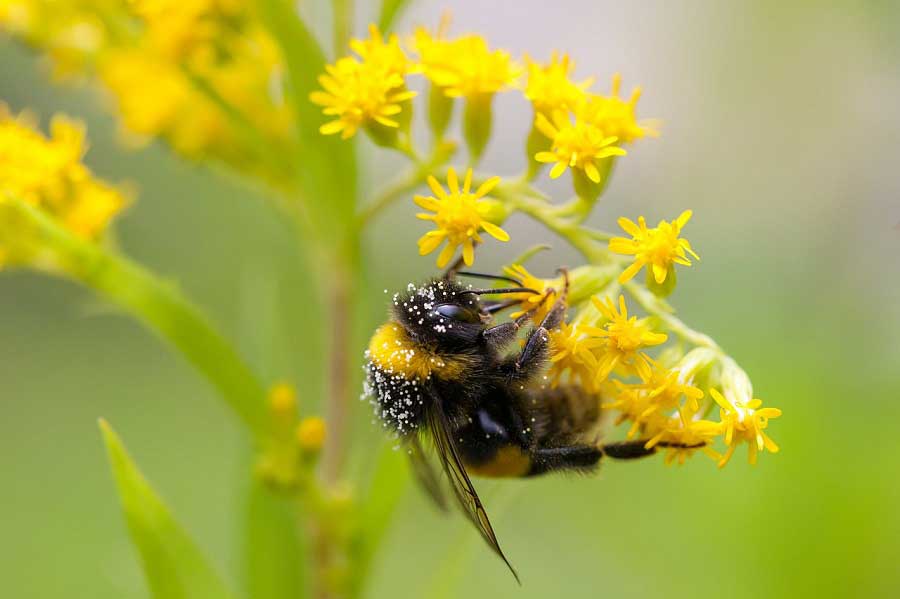The author takes the time to study his world in a way few of us do – slowly, deliberately, one vignette at a time. Today he considers goldenrod, both as part of something greater and as a world unto itself.
- by James Inabinet
I sat on a mat of leaves and leaned against a water oak to gaze along the bluff and bayou. A huckleberry sported a few, pale, “too-early” white blooms. Red maple bloomed around me too, some having already made fruit. I could see bright red samaras on a tree down the bayou, barely visible from my perch.
I closed my eyes to listen to a gentle breeze in the canopy. Bird sounds were curiously absent but for a single bird call: tew-tew-tew-tew-tew. I opened my eyes; a cloudless sulfur butterfly brushed by me followed almost immediately by another about twenty feet away. I closed my eyes again to listen to the southwest breeze and thunder. Spring rains would soon wash this place clean of pollen, but only temporarily. Minutes passed. With my eyes closed I felt a joy at being in this beautiful place at this auspicious time. Soon after, I got up and hiked to patch of goldenrods growing in the sun. I scanned the landscape from the east first, then sun-wise to the south and west, then north, mentally-noting everything I saw. In this place, goldenrods thrived. For several years now, I had been doing an informal study of goldenrods. I sought them wherever they grew, in fields, along ditchbanks, to rights-of-way, and the forest edge. I even found them in deep forest – they were everywhere. I conducted my study in the style of Goethe, the 18th century poet and scientist, who dreamed of a different kind of science than the one we’re used to. Goethe’s science is first a mutual interaction between seer and seen, a conversation among equals–goldenrod and human, an “I and Thou” instead of a “Me and It.” Such a study begins with receptive attentiveness. It’s a listening not a telling, a listening to what nature has to say instead of “the one who knows” telling nature what it is. In the course of the growing relationship, both partners change. My change is primarily in how I come to know the world, but nature changes, too. Any time we interact with nature, it is changed – even plants. It has been well documented that touching plants can affect their growth and that even our intentions can have an effect on them. What is required in Goethean science is to go beyond descriptions of plant-forms frozen in time. No plant freezes in time, but grows and becomes in a peculiar style, a unique way of becoming. This, the plant’s leitmotif, is how it expresses itself. To understand goldenrod-as-process, we must delve into goldenrod experientially, right where it grows, and explain its particular, individual form as it changes through time. My goldenrod observations are filled with descriptive terms and notes and sketches, as well as qualitative terms as to each goldenrod’s color, size, or shape. Context matters too; what lives with it, around it, on it. Again, it’s a plant-as-process. How does it make it through a year? What of the relation to its neighbors? What pollinates it? What eats it? What hides in it? Is it growing in sun or in shade? It matters! When grown in full sun, like on rights-of-way or old fields, it grows short and wide, its leaves narrow and long. Its flowers are huge, taking up the top third of the plant. Shade-grown goldenrod is completely different. Here it grows tall, up to eight feet in height and the leaves are quite large in comparison. It rarely flowers in shade, but when it does the flower head is diminutive, one-fifth the size of a flower head grown in the sun. Faithful to my study, I watched goldenrod; lived with them; smelled them; lay next to them, crawled in and among them. I noticed how they changed over a year as basal leaf rosettes grew new stems that leafed and flowered and turned into gray achenes. These the wind blew helter-skelter, sending the billowy fruits to new life somewhere else. I noticed old stems marking the place of dormant plants, many retaining the swollen elliptical mass of last year’s gall where a wasp used the stem as house and larder for its larvae. I observed an individual goldenrod’s relation to its neighbors, noticing the interplay of colors splashed upon its background, especially when animated by the wind. I stood at the edge of flowering goldenrod fields in fall and watched them duck and curl in a stiff breeze that pitched them into a dance. The wind provided the music, kissing each one, animating it, eliciting it to join in. All of these unique characteristics constituted a unique identity I call goldenrodness. As expected, over the year I changed too, if just to mark the joy of being here among them all, even as I thank God it’s no longer 2021. Enjoy this feature?
Enjoy the Shoofly Magazine? Reader donations help underwrite correspondents who write about and photograph our community.
Use the button below to join our Readers’ Circle! Comments are closed.
|
Categories
All
Archives
July 2024
|
Shoofly Magazine Partners
Our Shoofly Partners are local businesses and organizations who share our mission to enrich community life in Bay St. Louis, Waveland, Diamondhead and Pass Christian. These are limited in number to maximize visibility. Email us now to become a Shoofly Partner!



































 RSS Feed
RSS Feed























